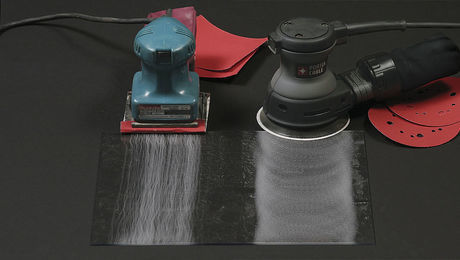Are you curious about random orbital sanders and how they work? Well, let me satisfy your curiosity with an engaging introduction! So, does a random orbital sander spin? The short answer is yes, but there’s more to it than meets the eye.
Picture this: you have a piece of wood that needs smoothing, and you’re thinking of using a random orbital sander. Now, imagine a small device with a round sanding pad that spins rapidly in a random pattern. That’s a random orbital sander in action!
But why does it spin in a random pattern, you ask? Great question! By spinning randomly, the sander prevents the formation of swirl marks on the surface being sanded. It ensures a smooth and evenly finished result, without leaving behind those pesky circular patterns.
Intrigued? Hold on tight, my curious friend, because we’re about to delve deeper into the fascinating world of random orbital sanders. So, let’s get ready to uncover the secrets behind their spinning magic!

Does a Random Orbital Sander Spin?
A random orbital sander is a versatile tool that is commonly used in woodworking and other DIY projects. But have you ever wondered if a random orbital sander actually spins? In this article, we will explore the inner workings of a random orbital sander, its unique sanding pattern, and how it differs from other sanders on the market. By the end, you’ll have a clear understanding of how a random orbital sander operates and why it’s the go-to choice for many craftsmen and DIY enthusiasts.
How Does a Random Orbital Sander Work?
When it comes to sanding surfaces, the random orbital sander is a popular choice due to its ability to provide a smooth and swirl-free finish. The unique sanding pattern of a random orbital sander is what sets it apart from other types of sanders.
A random orbital sander combines the spinning motion of a disc sander with the random orbit motion of an orbital sander. The sanding disc of the random orbital sander rotates in a circular motion while also moving in an elliptical path. This dual action ensures that the sanding patterns are random, minimizing the risk of leaving visible swirl marks on the surface being sanded.
The sanding disc of a random orbital sander is attached to a pad that is free to move in an eccentric motion. This pad not only provides the random orbit motion but also acts as a cushion between the sanding disc and the surface being sanded. This helps to distribute the sanding action evenly and prevent any deep scratches or gouges in the material.
Understanding the Dual Action of a Random Orbital Sander
Let’s dive deeper into the dual action of a random orbital sander and understand how it achieves its unique sanding pattern. When the sander is turned on, the sanding disc starts rotating in a circular motion. At the same time, the pad moves in an elliptical path.
The circular rotation of the disc ensures that the sanding is continuous, allowing the sander to remove material efficiently. The elliptical motion of the pad, on the other hand, creates the random orbit. As the pad moves, it changes the angle and direction of the sanding disc, preventing the formation of visible sanding marks on the surface.
The combination of these two movements results in a random orbit sanding pattern. This pattern eliminates the possibility of sanding marks or swirls and provides a smooth and uniform finish on different types of materials, including wood, metal, and plastic.
The Benefits of a Random Orbital Sander
Now that we understand how a random orbital sander works, let’s explore its benefits and why it is a popular choice among woodworking enthusiasts and professionals:
1. Versatility: A random orbital sander can be used on various materials, making it a versatile tool in any workshop. It can handle different sanding tasks, from rough sanding to fine finishing, without compromising on the quality of the end result.
2. Swirl-Free Finish: The random orbit sanding pattern of a random orbital sander ensures a swirl-free finish, making it ideal for projects that require a smooth and flawless surface.
3. Quick Material Removal: The dual action of a random orbital sander allows for efficient material removal, saving time and effort compared to other sanding methods.
4. Reduced Sanding Marks: The random orbit sanding pattern minimizes the risk of visible sanding marks or scratches on the surface, ensuring a professional-looking finish.
5. Comfort and Control: Random orbital sanders are designed with ergonomics in mind, offering comfort and control during prolonged sanding sessions. The vibration and noise levels are also significantly lower compared to other sanding tools.
6. Dust Collection: Many random orbital sanders come equipped with dust collection systems or attachments, keeping the work area clean and reducing the amount of dust inhaled by the user.
Common Questions About Random Orbital Sanders
How Does a Random Orbital Sander Differ from a Regular Orbital Sander?
The main difference between a random orbital sander and a regular orbital sander lies in the sanding pattern. While a regular orbital sander moves in a fixed circular motion, a random orbital sander combines circular and elliptical motions to create a random orbit sanding pattern. This pattern eliminates the formation of swirl marks and provides a smoother finish.
What Types of Projects Can I Use a Random Orbital Sander For?
A random orbital sander is suitable for a wide range of projects, including woodworking, furniture refinishing, paint removal, and prepping surfaces for painting or staining. It can be used on various materials such as wood, metal, plastic, and even drywall.
Tips for Getting the Best Results with a Random Orbital Sander
To get the best results with a random orbital sander, keep the following tips in mind:
1. Choose the Right Grit: Select the appropriate sandpaper grit for your project. Coarse grits are ideal for removing material quickly, while finer grits are better suited for achieving a smooth finish.
2. Start with Light Pressure: Apply light pressure when sanding to prevent any deep scratches or gouges. Let the weight of the sander do the work for you.
3. Keep the Sander Moving: Avoid staying in one spot for too long. Keep the sander moving at a steady pace to prevent uneven sanding and heat buildup.
4. Use Proper Sanding technique: Sand in the direction of the wood grain or in a crosshatch pattern, depending on the desired finish.
5. Change Sandpaper Regularly: Replace the sandpaper when it becomes worn or clogged with dust to maintain optimal performance.
6. Wear Protective Gear: Always wear safety goggles, a dust mask, and ear protection when using a random orbital sander to protect yourself from dust and noise.
In conclusion, a random orbital sander does indeed spin, but it also moves in an elliptical path, creating a unique sanding pattern known as a random orbit. This motion ensures a swirl-free finish, making the random orbital sander a versatile and efficient tool for various sanding tasks. Whether you’re a DIY enthusiast or a professional woodworker, a random orbital sander should be a staple in your toolbox for achieving smooth and professional results.
Key Takeaways: Does a Random Orbital Sander Spin?
- A random orbital sander does spin, but in a random pattern, hence the name.
- The spinning motion allows the sander to remove material evenly and minimize swirl marks.
- The random orbit prevents the sander from leaving circular patterns on the surface being sanded.
- The random movement also makes the sander less likely to cause gouges or scratches.
- Random orbital sanders are great for smoothing surfaces and are commonly used in woodworking and refinishing projects.
Frequently Asked Questions
Welcome to our FAQ section on random orbital sanders! Here, we’ll answer some common questions about these powerful tools and their spinning capabilities.
How does a random orbital sander work?
A random orbital sander is a versatile power tool used for sanding and smoothing surfaces. Unlike other sanders, it combines both rotary and orbital motion, which not only spins the sanding disc but also moves it back and forth in a random pattern. This random motion prevents swirl marks and ensures a smoother finish.
By spinning the sanding disc while oscillating it, a random orbital sander removes material quickly and efficiently. The random orbital motion also reduces the risk of sanding in gouges or leaving visible marks, making it a great choice for both professionals and DIY enthusiasts.
Does a random orbital sander spin in a circular motion?
Yes, a random orbital sander spins, but not in a strictly circular pattern like a traditional rotary sander. Instead, it combines a spinning motion with an elliptical or random orbit. This random orbit ensures that the sanding disc moves in a multidirectional pattern, reducing the chances of leaving unsightly swirl marks on the surface.
While the spinning motion is an essential aspect of a random orbital sander, it’s the combination of this spin with the back-and-forth random orbital motion that sets it apart and makes it such an effective tool for sanding projects.
What are the advantages of using a random orbital sander?
Using a random orbital sander offers several advantages. First, the random orbital motion ensures a smoother finish by minimizing swirl marks. Additionally, the dual-action of spinning and oscillating reduces the likelihood of sanding through the material or leaving visible marks.
Random orbital sanders are also more forgiving when it comes to sanding across the grain. Whether you’re working on wood, metal, or plastic, the random orbital motion helps avoid streaks and uneven surfaces. These sanders are also generally less aggressive and easier to control than other types of sanders, making them suitable for beginners and experts alike.
Can a random orbital sander be used for polishing or buffing?
Yes! Random orbital sanders can be used for more than just sanding. With the right attachments, such as a polishing pad or buffing bonnet, you can transform your random orbital sander into a versatile tool for polishing and buffing tasks.
However, it’s important to use the appropriate speed and technique when switching from sanding to polishing. Make sure to use a low-speed setting and apply minimal pressure to avoid overheating or damaging the surface. Additionally, always choose the correct type of polishing compound for the material you’re working on to achieve the best results.
Are there any safety precautions to consider when using a random orbital sander?
Yes, safety should always be a priority when using power tools. When using a random orbital sander, it’s important to wear protective gear such as safety goggles and a dust mask to shield your eyes and lungs from fine particles and debris. It’s also advisable to work in a well-ventilated area or use a dust collection system to minimize dust exposure.
Additionally, ensure that the sanding disc is properly secured and aligned before turning on the sander. Always follow the manufacturer’s instructions and avoid applying excessive pressure when sanding to prevent injury or damage to the workpiece. Lastly, remember to disconnect the power source before changing sanding discs or performing any maintenance on the tool.

Why I HATE my random orbital sander (and how to fix it)
Summary
So, to wrap it up: a random orbital sander does indeed spin! Unlike other sanders that just spin in one direction, a random orbital sander spins in a circular motion while also vibrating. This unique movement helps to prevent swirl marks and creates a smoother finish on your projects. It’s a great tool for sanding wood, metal, or even plastic surfaces. Just make sure to hold it steady and let the sander do the work for you. Remember to wear safety goggles and a mask to protect yourself from debris and dust. Happy sanding!
